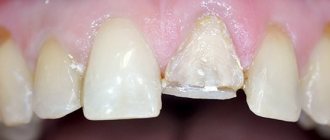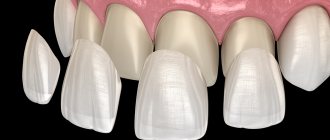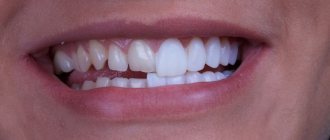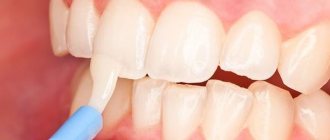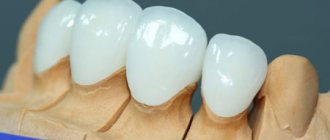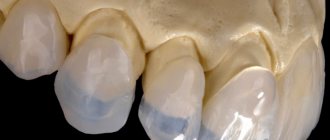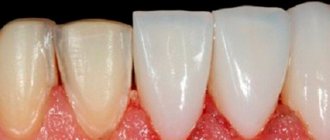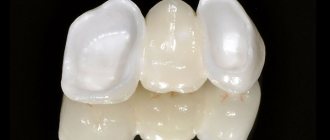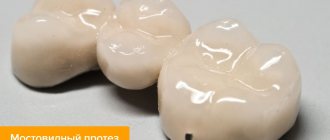Dental veneers are a type of prosthetics that covers the front part of the tooth. As a result, it looks much more aesthetically pleasing. Dental veneers are microprostheses. With their help, you can restore the shape and color of one tooth or a whole row.
Restoration with veneers involves fixing them to the front part of the tooth. They are used to restore the appearance of teeth that fall into the smile line.
The best veneers are virtually indistinguishable in appearance from real teeth. Their color is selected to match the natural one.
In dentistry, veneers are used when whitening or restoring enamel by other methods does not provide the desired effect. Restoration is carried out as soon as possible.
What are veneers and why are they needed?
Veneers should be made to restore the aesthetic appearance of your smile. It is better to place them in pairs so that the teeth look the same. The pads look like real ones. You can install up to 10 teeth on both jaws.
Dental veneers are a type of prosthetics that covers the front part of the tooth. As a result, it looks much more aesthetically pleasing.
Veneers are needed if:
- not satisfied with the natural color of your teeth;
- restoration of the integrity of the enamel is required;
- you need to change the size and shape of the tooth;
- Correction of enamel abnormalities is required (for example, if there is hypoplasia);
- to eliminate interdental spaces.
Veneers mask any imperfections, making your smile beautiful.
Contraindications and restrictions
Unfortunately, in some cases, veneers are contraindicated as a means of restoring the aesthetics of a smile. For example, when:
- large-scale destruction of the front teeth;
- multiple fillings on the front teeth;
- malocclusion: veneers can further aggravate the situation;
- pathological grinding of teeth - bruxism. Under constant load, the linings will become unusable too quickly;
Dentists do not recommend installing veneers for those patients who are not willing to spend extra minutes of precious time on dental care.
Until recently, the removed pulp was an absolute contraindication for installing veneers. But today technology has stepped forward, and this issue is resolved individually.
For what purposes do dentists use veneers?
Dentists use veneers for dental prosthetics. Unlike a crown, they are placed only on the front part of the tooth, hiding its flaws. Teeth with onlays look both aesthetically pleasing and natural.
If other restoration work has not produced the desired effect, and the patient wants to look different with a more beautiful smile, custom dental veneers are also used. The dentist can also prescribe them if there are large gaps between the teeth. In the clinic, onlays can be fixed to both the lower and upper teeth.
Veneers for aesthetics
Veneers can make your smile look great. At the same time, it can look natural. Veneers on the front teeth can change their color, which has deteriorated after root canal treatment and the use of tetracycline. They are also excellent for correcting short, misshapen teeth. To do this, veneers are fixed to crooked teeth.
You can install veneers to eliminate gaps between teeth and solve the problem of a gummy smile. Overlay veneers can also help if there is weak muscle tone in the lower area of the face and skin. The color of veneers is selected individually in each case. When installed on chewing teeth, you can achieve a lifting effect for the cheekbones. Even if there is one problematic front tooth, this problem can be easily solved.
Functional purpose of veneers
The use of veneers can correct not only aesthetic problems, but also bite problems. In this case, we are talking about the incorrect relationship of the teeth. This is what needs to be corrected.
Microprostheses will allow you to make your jaw look correct. They are able to adhere well and eliminate various defects, including cracks in the teeth, uneven rows, and existing gaps.
Is it worth putting veneers on the weight of the teeth? Theoretically, this is possible, but most often they are fixed only on the smile line - 8 lower and 10 upper teeth.
Teeth onlays to correct bite
If the patient has no complaints about the enamel and is only interested in correcting crowded teeth, the doctor may suggest treatment with special mouthguards or aligners. Unlike fixed orthodontic structures, they can be removed during meals and during oral hygiene procedures. They are practically invisible on the teeth, as they are made of transparent material. Due to their tight fit to the dentition, removable onlays promote gradual teeth alignment. The disadvantage of treatment with mouthguards is their limited effect. If you have a complex case, then it is better to opt for aligners, which are as effective as braces.
What you need to know before installing veneers
Before installation, you need to decide on the material and coordinate the color.
Before installation, you need to decide on the material and coordinate the color. You also need to know that a layer of enamel will be removed from the hard tissue of the tooth. What it will be is determined based on the thickness of the veneer.
First, patients are fitted with temporary veneers. The final version is then produced and delivered for daily use. If you don’t want to grind down your tooth, it’s better to choose thinner designs – lumineers.
Are veneers right for you?
Anyone who has no contraindications to them can have orthopedic structures installed. The main purpose of veneers is to eliminate visual defects of teeth.
If there is a discoloration of the enamel, chips, stains, or other defects, overlays are indicated for use. With their help, you can cope with both trema and diastema, and lengthen or shorten teeth. An aesthetic onlay can also visually correct the position of individual units of a row of teeth, for example, slightly rotate a canine.
Indications for installation
Indications for the installation of turnkey veneers are as follows:
- there is a pronounced yellowness of the enamel;
- the shape of the tooth is irregular;
- there are old fillings whose color is clearly different from the enamel of your teeth;
- there are defects in hard tissues;
- have fluorous teeth;
- change in shade after depulpation;
- there is enamel erosion;
- to straighten a misaligned tooth;
- you can use overlays to create a Hollywood smile;
- the teeth are wedge-shaped;
- stains and chips appeared on the tooth;
- Tremas and dysthemas are present.
If there are diseases such as necrosis, enamel erosion or hypoplasia, veneers can be an excellent solution. With necrosis, the enamel is destroyed. Erosion is signaled by the appearance of oval or round shaped destruction of hard tissue. Hypoplasia is characterized by the absence of part of the enamel. With fluorosis, white spots appear on the enamel, which then turn brown.
Contraindications
Veneers should not be installed in the following cases:
- insufficient volume of enamel;
- there are some types of bite pathologies;
- lack of a large number of chewing units;
- bruxism;
- destruction of more than half of the tooth.
A doctor will help determine contraindications. To do this, they undergo an examination of the oral cavity.
Veneers pros and cons
Installing veneers has pros and cons. Fixing the structure takes only a couple of weeks. After this, your teeth will look perfect, both shape and color.
On the downside, your teeth may become sensitive. Eating very hot or cold food will be problematic. However, such inconvenience occurs very rarely and is rather the exception.
Which veneers to choose
Which veneers are right for you? It all depends on the indications determined by the dentist. The choice should be made based on the strength characteristics, the desired shade, and the scale of tooth destruction.
It also takes into account how many veneers will be needed. You can put one overlay, or 10 on each jaw.
Jewelry on teeth
When your teeth are healthy, but you still want your smile to attract even more attention from others, patients turn to aesthetic dentistry to have onlays placed on their teeth for beauty: skys and grills.
Skyes
– decorative overlays on teeth, which are used to decorate the enamel or camouflage a small defect. These can be gold and silver overlays for teeth, as well as platinum and combined ones - using crystal, Swarovski crystals and precious stones.
Skyce installation is carried out using two methods. The first involves attaching the onlay directly to the tooth: a depression is made on the surface of the tooth, and the stone is fixed in it using a composite material. But inlay is a rare occurrence in dentistry, since not everyone wants to have an extra hole in a healthy tooth. In the second case, microprosthetics is used: the skye is installed on an onlay (veneer), previously made from an impression, then the onlay is attached to the tooth surface using filling materials. Such dental overlays help hide more serious enamel defects.
Grillz
– removable dental onlays, which are installed on both one and several front teeth. They are popular among celebrities and are usually quite expensive because they are custom-made from precious metals. Silver, gold and platinum dental overlays can be encrusted with diamonds, emeralds and rubies. However, grillz do not necessarily have to be made of gold or other precious metals. They can be made from inexpensive metals with rhinestones and not individually, but according to a template. In this case, the price for such dental overlays will be more affordable.
Veneer manufacturing technology
All methods for producing veneers can be systematized as follows:
- Layer-by-layer application. In this case, the onlay is made on platinum foil, which is fixed around the ground tooth on a plaster model. Afterwards the mass is fired. The technician applies the ceramic and fires it. The cost of this technology is lower than that of others.
- Casting method. Wax overlays are modeled on the model. Then they are transferred to the sprue and packed in a special mass. Next, a frame is formed under vacuum conditions. After casting, coloring occurs. Veneers made in this way have an excellent fit.
- Computer modelling. It will take several hours to make a veneer: at least 1 hour for milling and a few more hours for the dental technician to finish the veneer. It is possible to install a veneer in this way within one day, if you visit a doctor in the morning and take a scan of the tooth, and come back in the evening to fix the finished veneer. The structure is attached to the tooth with a material that hardens on its own.
Making ceramic veneers
After collecting the patient’s medical history and clarifying his wishes, the doctor begins preparing the enamel. There are several main stages of work:
- making Wax-up - an example of a future design on a model;
- transfer of this option to the oral cavity - Mock-up;
- cleaning enamel from food and plaque;
- selection of the desired shade;
- preparation of enamel to the desired thickness;
- making a cast of the jaws;
- installation of temporary structures;
- casting a model from plaster;
- production of ceramic veneers;
- fitting of the overlay, correction and fitting;
- installation and fixation of the veneer using a special composition.
Manufacturing of composite veneers
Composite veneers are thin overlays fixed to the front of the tooth. They are made from filling material. They are placed directly in the oral cavity. Their service life is 5 years.
The production process looks like this:
- a specialist examines the oral cavity, identifies teeth that require the installation of onlays;
- composite material is applied;
- teeth are sharpened;
- composite restoration is carried out;
- the pads are sanded.
How to install veneers on teeth
Veneers are installed only on healthy teeth.
Veneers are installed only on healthy teeth. That is, gum disease and caries should be treated initially.
- First, the color is selected using a special scale.
- Then the tooth is turned or prepared.
- Next, an impression is taken, in each case individually.
- Afterwards, temporary linings must be attached.
- Then the veneers are directly fixed using adhesive technology to cement, which is then polymerized using a special lamp. The process takes up to 90 minutes.
- Once the pad is fixed in the correct position, the glue is dried with air. How are veneers placed without grinding down teeth? This is only possible in one case: if you have chosen more expensive analogues in the form of lumineers.
With turning
In most cases, tooth preparation is necessary before installing veneers. The technique consists of making special grooves on part of the tooth. The depth is determined using a special drill. Treatment is carried out up to the gum. The enamel is removed to a depth of 1 mm.
The teeth for veneers are polished and sprayed with a degreaser. Then they are treated with a special chemical.
Preparation for veneers can be performed in different ways. This can be a direct method - it is used in the process of fixing straight structures. In this case, there is no need to completely remove the enamel; it is enough to process some areas.
An indirect method can also be used. It is used when veneers need to cover the outer surface of a tooth. If you remove too little enamel in this case, the effect of “horse teeth” may appear.
Without turning
Veneers can be installed without grinding only in one case - if they are expensive lumineers. First, a consultation is held with a specialist. He examines the patient and decides whether it is possible to place onlays without grinding down the teeth.
Fixation is performed over several visits. The overlays are produced in a special laboratory. They are sanded, polished and painted. After a follow-up inspection, they can be installed on the same day.
How to remove veneers
If the pads are attached correctly, they can only be removed in a medical facility. Even if they have moved away from the enamel, it will not be possible to perform the procedure at home. Clinics use 2 main methods:
- cut down The overlay is removed using a bur;
- peel off. The cement is evaporated using a laser device.
Any manipulations are carried out under anesthesia. The patient does not experience any discomfort.
Adhesive false teeth
False teeth that stick easily after being placed in hot water and also have a whitening effect. They are easy to carry, do not interfere with natural communication, and do not fall. Do not cause itching or discomfort. A full-fledged imitation of natural gums and the teeth themselves, there are, of course, disadvantages that you can’t eat or sleep in them, well, sleep is okay, but you can’t go on a visit with them somewhere, somehow it won’t be aesthetically pleasing to take them off at the table, but This is what you need for selfies and other photos.
| Material | silicone |
| Color | white |
| Length | 7 cm |
| Rating | 4.9 out of 5 |
Link
What types of veneers are used in aesthetic dentistry: by type of material
The main criterion for classifying overlays is the type of material used. Veneers can be ceramic, made from a composite mixture, etc. All types of overlays differ from each other. The varieties are also installed differently.
Ceramic veneers
Ceramic veneers require indirect prosthetics. They are pre-made in the laboratory and then placed on the patient.
Among the proposals for front teeth, emax veneers are recognized as one of the best. They are as durable as possible and look aesthetically pleasing. Unlike standard ceramic onlays, E-max is made from pressed lithium silicate ceramic. The composition was developed by the leading German company Ivoclar Vivodent.
Cast glass ceramics
Veneers are produced from cast ceramics, characterized by high performance and aesthetic properties. Their performance is superior in comparison with porcelain. The main advantage is that there is no need for preparation.
Hot press ceramics
Veneers of this type are produced using the injection molding method under high temperature. The results are durable microprostheses that are resistant to chewing loads. They are thin and light.
At the same time, the pads are hypoallergenic and more durable. The main disadvantage is the impressive cost.
Traditional feldspar ceramics
Such veneers are made from a special powder obtained during firing and subsequent cooling of the crushed workpiece. The material has high aesthetic characteristics. It is excellent for dental prosthetics, regardless of their location.
Composite veneers
Composite veneers are inexpensive. Their appearance is natural. Overlays are made from a special material that is applied in layers. They are distinguished by ease of installation, but the quality does not suffer from this.
Porcelain veneers (Hollywood laminates)
Porcelain veneers or lumineers are considered one of the main achievements in dentistry. They look like thin plates and are placed on the front of the teeth. The color of the overlay is selected by the patient together with the doctor. Veneers are simply glued on, after etching the surface of the natural tooth to make it rough.
Zirconium veneers with application
These overlays are formed from an alloy with zirconium. The material is highly durable and perfectly compatible with teeth. The effect of its use is excellent. The only negative is the high cost.
Plastic veneers (temporary)
Temporary veneers are used after the enamel has been prepared and impressions have been taken. It takes time to produce permanent overlays. During this period, already ground enamel looks ugly. To hide the defect, temporary overlays are used. They also perform the function of protecting teeth from bacteria, temperature, food and plaque.
Plastic veneers are attached with adhesive and can be easily removed in the dental office.
Removable veneers - they don’t exist
Are there removable veneers? In fact, there are none. The onlays, which appear in advertising every now and then, are attached to 10-12 teeth in a row. They are flat models with imitation gums. They are attached directly to the teeth.
Manufacturers claim that such overlays are suitable for any jaw. In practice, everything looks different.
Technique for installing onlays for restorative bleaching
Straight
– application of onlays on teeth made of composite material occurs directly on the enamel without preliminary production in the laboratory.
Indirect
– the thinnest (up to 0.3 mm) dental overlays are attached to the teeth – lumineers and ultraneers, pre-made in the laboratory individually based on a dental impression.
In addition to the listed methods, you can lighten the enamel by several shades using removable trays, which are used for whitening at home. They work due to a special whitening gel placed in the plate. You need to wear them for an average of an hour a day. But, unlike lumineers or composite veneers, it is not possible to accurately “predict” the result in advance, since it depends on the individual characteristics of the patient.
Alternatives to Veneers: What's the Difference and Which is Better?
An alternative to veneers are other methods of aesthetic dental restoration, namely crowns, dentures, and restoration.
Which one to choose is decided by the attending physician. An alternative to veneers are other methods of aesthetic dental restoration, namely crowns, dentures, and restoration. Which one to choose is decided by the attending physician based on the patient’s specific indications.
Veneers or crowns
The main difference is the depth of enamel processing. Veneers cover only part of the tooth. Crowns cover the entire tooth. In this case, the first option wins. Crowns look less natural. However, they are irreplaceable if the tooth is severely damaged.
In any case, both types of restoration have their own strict indications for use, and in this case the attending physician decides which option is more suitable for the patient, depending on his specific indications.
Veneers or restoration
Is there a difference between restoration and veneers? Restoration involves restoring the integrity of the canines or incisors. It refers to a cosmetic procedure. Its main goal is to achieve an aesthetic smile.
Veneers are a subtype of restoration, its indirect method. This method involves fixing onlays to a tooth that has a defect. At the same time, aesthetics are also restored.
Veneers or dentures
Prosthetics are indicated for a patient if there is complete or partial loss of dentition, or a significant cosmetic defect. If a large number of teeth are missing, a denture may be prescribed. Veneers are used if there is enough enamel on the teeth, but there is a need to change the shade or shape of the tooth.
Composite onlays for teeth
Therapeutic, or composite, onlays for teeth are used in cases where the goal is to build up a badly damaged tooth, and not just improve aesthetics. For example, they can be used in case of severe chipping of the incisor (more than half the area) or in other cases when orthopedic veneers are simply useless due to the impossibility of their installation. Such dental overlays are made using the direct method, that is, immediately on the patient’s tooth, from composite materials, hence their name – composite veneers. Therapeutic overlays have a standard color range, so in some cases the patient cannot choose the appropriate shade. The advantage of this type of onlay is that the patient receives a visible result in one visit; in addition, the price of onlays for teeth made of a composite is significantly lower than classic ceramic veneers.
Recovery and rehabilitation period
You should not eat until the anesthesia wears off after the veneers are installed. Don't bite or chew anything. Also, after the procedure, a combination of taking hot and cold together is not recommended.
You should definitely come for a preventive examination. Your doctor should schedule a date for you to check that your teeth are aligned correctly.
If you have problems such as bruxism or malocclusion, you should wear special protective mouth guards. Also, do not neglect preventive examinations. Another important point is that after installing veneers, you should periodically perform oral hygiene (2 times a day or after each meal).
Indications for installation
Dentists usually suggest thinking about installing veneers to those patients for whom enamel whitening has proven ineffective, for example, with incomplete amelogenesis, fluorosis, so-called tetracycline teeth.
Moreover, sometimes these 2 procedures very often go hand in hand: first, the doctor lightens the enamel, waits at least 2 weeks for the natural shade of the teeth to be restored. Then the color of the veneers is selected and they are installed. This approach allows you to brighten your smile as much as possible.
In addition to lightening tooth enamel, indications for installing onlays are:
- traumatic chipping of a front tooth;
- unaesthetic gaps (trema and diastema) between teeth;
- pigmentation of the filling and pigment spots on the tooth tissue around the restorative structure;
- any non-carious defects of enamel and dentin;
- cracks on the tooth;
- exposure of the tooth root - gum recession.
For patients with a deep bite, veneers will be a good alternative to a crown, since in this case there is too little space on the oral surface of the teeth to install an oversized structure.
Discount on veneers up to 30%! Details from administrators
Moscow
Only a doctor can say for sure whether it is possible to correct a particular defect by installing veneers. You can always ask other questions about ceramic and composite onlays in our dental center. Professionals work here, who every day give their patients the opportunity to smile without embarrassment.
